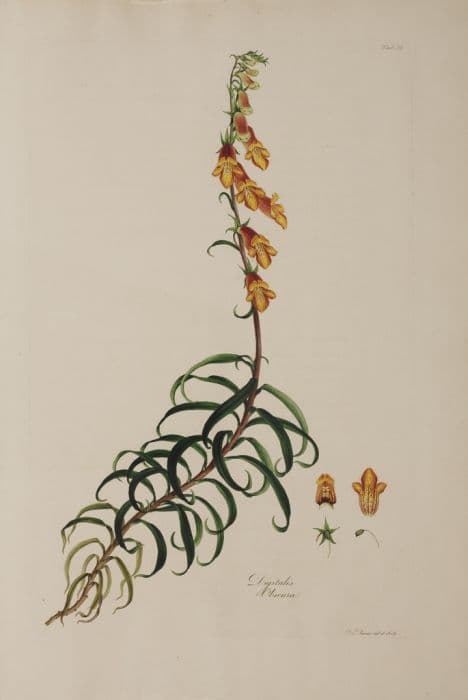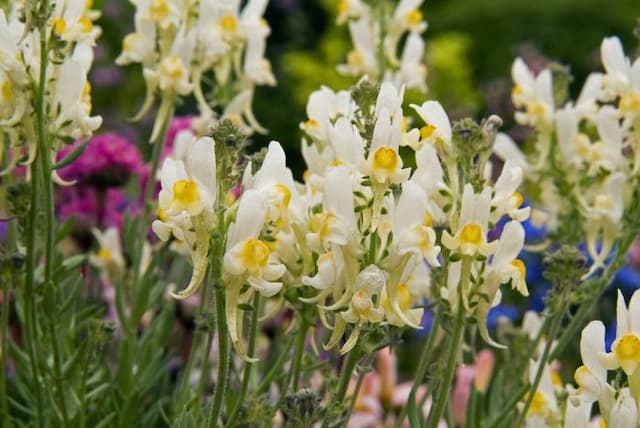Willow-leaved foxglove Digitalis obscura

ABOUT
The Digitalis obscura, commonly known as the willow-leaved foxglove, boasts a distinct and picturesque appearance. This perennial plant is easily recognizable by its lance-shaped, willow-like leaves that have a gray-green hue, exuding a sense of wild elegance. The foliage tends to form a low rosette at the base, from which emerges the striking feature of the plant: its flowers. The flowers are a captivating spectacle. They are tubular in shape, resembling elongated bells with a slight twist, and they hang gracefully from the towering stem. The color of the blooms is a blend of orange and red, intermixed with subtle veins of a darker hue, creating a warm and inviting display. As the flowers mature, they produce a distinctive contrast against the foliage – a dance of color that is particularly attractive to garden enthusiasts and pollinators alike. The overall impression of the Digitalis obscura is one of rustic charm, with a touch of the exotic, thanks to the unusual coloring and form of its blooms.
About this plant
 Names
NamesFamily
Plantaginaceae
Synonyms
Willow-Leaved Foxglove, Sunset Foxglove
Common names
Digitalis obscura.
 Characteristics
CharacteristicsLife cycle
Perennials
Foliage type
Evergreen
Color of leaves
Green
Flower color
Orange
Height
2 feet (0.61 meters)
Spread
1 foot (0.30 meters)
Plant type
Herb
Hardiness zones
8
Native area
Mediterranean
Benefits
 General Benefits
General Benefits- Aesthetic Appeal: Digitalis obscura, commonly known as Sunset Foxglove, adds ornamental value to gardens with its attractive, tubular, reddish-brown flowers.
- Attracts Pollinators: It serves as a nectar source for bees and hummingbirds, aiding in the pollination of surrounding plants.
- Drought Resistance: Adapted to dry environments, it can thrive in areas with low water availability, making it suitable for xeriscaping.
- Wildlife Habitat: Provides shelter and breeding grounds for certain species of insects and small animals.
 Medical Properties
Medical Properties- Cardiac glycosides content: Digitalis obscura contains cardiac glycosides that are used in the medical field to treat certain heart conditions.
- Heart rate regulation: The compounds in Digitalis obscura can have effects on heart rate, potentially useful in treating arrhythmias.
- Positive inotropic effect: The plant's cardiac glycosides can increase the force of heart muscle contraction, which can be beneficial in heart failure cases.
 Air-purifying Qualities
Air-purifying QualitiesThis plant is not specifically known for air purifying qualities.
 Other Uses
Other Uses- Digitalis obscura, commonly known as Sunset Foxglove, can be used as a natural dye, providing colors ranging from yellow to green depending on the mordant used.
- In small, controlled amounts, Sunset Foxglove can be added to compost heaps as a natural activator to accelerate the decomposition process, although caution must be taken due to its toxic properties.
- The plant can serve as an educational tool in botany and horticulture courses to demonstrate plant adaptation, survival strategies, and the ecological significance of toxic compounds in plants.
- Sunset Foxglove's tall and striking flowers can be used in landscape design to add height and color contrast in perennial borders or wildflower gardens.
- Dried Sunset Foxglove flowers can be incorporated into floral arrangements or potpourris as an ornamental element, being mindful to handle them with care due to their toxicity.
- The dried leaves of the plant may be used in artistic endeavors, such as botanical printmaking or eco-printing, to create unique patterns on paper or fabric.
- Due to its unique shape and coloration, the Sunset Foxglove can be a fascinating subject for photography, especially macro photography, which can highlight the intricate details of its flowers.
- Incorporating Sunset Foxglove into a garden can help with biodiversity by attracting bees and hummingbirds, which are drawn to its tubular flowers for nectar.
- The robust root system of Sunset Foxglove can aid in soil stabilization, making it a potential candidate for planting in areas prone to erosion.
- Harvested seed pods from the Sunset Foxglove can be used in craft projects or as a natural decoration element, being sure to avoid any consumption or accidental dispersion in non-native areas.
Interesting Facts
 Feng Shui
Feng ShuiDigitalis, commonly known as Foxglove, is not used in Feng Shui practice.
 Zodiac Sign Compitability
Zodiac Sign CompitabilityFoxglove is not used in astrology practice.
 Plant Symbolism
Plant Symbolism- Healing: Digitalis, commonly known as foxglove, is well-known for its medicinal properties, particularly for its use in treating heart conditions. Its symbolism is often associated with healing and medicine.
- Protection: The striking appearance of foxglove is sometimes considered a symbol of protection, as it was believed to repel evil spirits in folklore.
- Toxicity: Despite its medicinal uses, foxglove is poisonous, and this aspect symbolizes the dual nature of many plants – being both helpful and harmful, symbolizing caution and awareness.
- Magic and enchantment: Foxglove has a place in folklore and fairy tales, oftentimes associated with magical creatures and enchantment, reinforcing its otherworldly associations.
 Water
WaterFor Willow-leaved Foxglove, it's important to maintain moderate moisture levels, watering deeply whenever the top inch of soil feels dry—typically, this may translate to watering once every week or two, depending on climate conditions. Use about one gallon of water per plant to ensure it reaches the deeper roots. Overwatering should be avoided, especially during the winter months when the plant requires less water. Adjust the watering frequency based on seasonal weather variations, watering more often during hot, dry periods and reducing during cooler, rainy seasons.
 Light
LightWillow-leaved Foxglove thrives in full sun to partial shade. The ideal location provides morning sunlight and afternoon shade, especially in hotter climates, to protect it from the intense midday sun. Avoid deep shade as it can lead to poor flowering and a weak, leggy growth habit.
 Temperature
TemperatureWillow-leaved Foxglove prefers temperature conditions between 60°F and 80°F for optimal growth. It can tolerate a minimum temperature down to 30°F but is not frost-hardy, and temperatures over 90°F may stress the plant. The ideal temperature range offers a mild climate, reflecting its native mountainous habitat.
 Pruning
PruningPrune the Willow-leaved Foxglove after blooming by deadheading spent flowers to encourage further blooming and prevent self-seeding if not desired. Cut back foliage in the fall, after the plant has gone dormant, to help maintain tidiness. Pruning is generally done annually or as needed to remove dead or damaged stems and promote a compact, healthy growth form.
 Cleaning
CleaningAs needed
 Soil
SoilThe best soil mix for Sunset Foxglove should be well-draining and fertile with a slightly acidic to neutral pH between 5.5 and 7.0. A mix containing loam, peat, and perlite or sand works well to provide the needed drainage and nutrient content.
 Repotting
RepottingSunset Foxglove, being a perennial, does not need frequent repotting. It is typically repotted every 2 to 3 years, and only when it has outgrown its current container or the soil is depleted.
 Humidity & Misting
Humidity & MistingSunset Foxglove prefers moderate humidity levels. It thrives best in outdoor conditions where natural humidity is present but can adapt to less humid environments as long as the soil moisture is maintained appropriately.
 Suitable locations
Suitable locationsIndoor
Place in bright, indirect light and water when top soil is dry.
Outdoor
Full sun to partial shade, well-draining soil, water regularly.
Hardiness zone
4-8 USDA
 Life cycle
Life cycleThe life of the Digitalis obscura, commonly known as Sunset Foxglove, begins with the germination of seeds sown in well-draining soil, preferably in late winter to early spring. Seedlings emerge and establish a basal rosette of leaves, which is the vegetative growth stage, during the first growing season. Following vegetative growth, it enters a period of vernalization over winter, which is essential for floral induction. In the second year, the plant bolts, sending up tall flower spikes adorned with tubular, reddish-orange flowers, marking the reproductive stage where pollination occurs, typically by bees and other insects. After pollination, the flowers develop into seed capsules that release numerous tiny seeds when mature, ensuring the dispersal of the plant. Finally, the plant completes its life cycle by senescence and death after seed set, which can vary from a biennial to a short-lived perennial cycle, depending on environmental conditions.
 Propogation
PropogationPropogation time
Spring-early summer
Propogation: Digitalis obscura, commonly known as Sunset Foxglove, is most commonly propagated through seeds. The best time to sow these seeds is either in late winter or early spring to allow for a full season of growth. The process involves sowing the seeds on the surface of well-drained soil mix and lightly pressing them into the soil, as they need light to germinate. Once sown, they should be kept moist and ideally at a temperature range of 65-70°F (about 18-21°C). Germination can be expected in two to four weeks. Seedlings can later be transplanted outdoors after the risk of frost has passed and they've grown sufficiently to handle environmental stresses. The simplicity of seed propagation makes it the most popular method for increasing Sunset Foxglove numbers.







![Hebe [Garden Beauty Blue]](/_next/image?url=https%3A%2F%2Fplants-admin.emdemapps.com%2Fimages%2Fplants%2F%2Fimages%2F604b58cbcb4e2.png&w=640&q=75)

![Hebe [Garden Beauty Purple]](/_next/image?url=https%3A%2F%2Fplants-admin.emdemapps.com%2Fimages%2Fplants%2F%2Fimages%2F604b646a3d922.png&w=640&q=75)